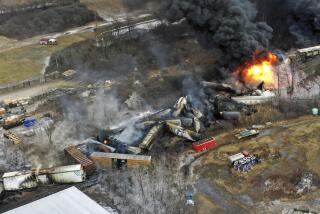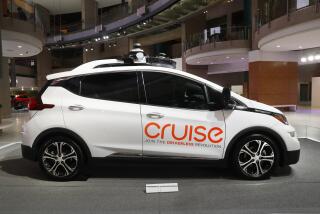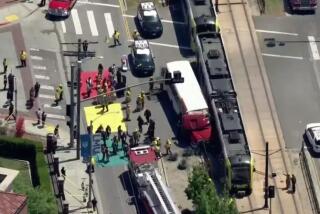Conflicts Cited in Cable Car Crash Probe
- Share via
SAN FRANCISCO — Passengers and the grip man insisted the brakes did not work as a cable car sped down the rain-slick Hyde Street tracks and rear-ended a truck, but police and transit officials differed Tuesday over details of the crash that injured 31 people.
“From what we can determine, everything was done the way it should have been done,” said Officer Bill Dyer, one of two officers involved in preliminary investigation of Monday’s mishap near Fisherman’s Wharf. “What we don’t know is if everything worked the way it should have.”
San Francisco Municipal Railway officials said the track brakes, wheel brakes, grip and other parts were in good working order when tested after the accident occurred on a 21-degree grade.
“As far as we can tell at this point, everything worked,” said Don Cameron, Muni’s general superintendent for rail transportation who is heading the district’s investigation.
Another point of contention is how fast the No. 13 car was moving before the collision, which spilled many riders into the intersection of Hyde and Bay streets.
Passenger F. George Dirschka, 60, an investigator with the Florida state attorney’s office, said the crew pulled various levers but the car did not slow. “There is no question we were doing at least 20 m.p.h.,” he said.
“We knew something was wrong,” rider Richard Patterson said. “We were going faster than we should have been. People knew we weren’t going to stop.”
Other passengers estimated the speed as high as 40 m.p.h.
But Muni spokesman George Newkirk said that while passengers felt the car was out of control, it was still connected to the underground cable, which moves at 9.5 m.p.h. down hills.
“If that car had been going 40 m.p.h., we’d have had dead people on the street,” Newkirk said.
But Dyer said that from the damage to the cable car and utility truck, it appeared that the No. 13 car was going 20 to 25 m.p.h. The impact ripped off the front of the car and crushed the rear of the truck.
Police said the emergency brake, which jams a steel wedge into the cable slot, had not been applied until the cable car reached the middle of the intersection--0 to 30 feet past the impact point, the San Francisco Examiner reported Tuesday.
But a veteran grip man told the paper that the emergency brake did not work well going downhill at speeds over 15 m.p.h.
“I got so many conflicting stories at the scene that I got more confused than anything else,” Cameron said.
More to Read
Sign up for Essential California
The most important California stories and recommendations in your inbox every morning.
You may occasionally receive promotional content from the Los Angeles Times.










